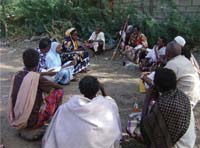9.2.3 Non-verbal communication
Non-verbal communication is the process of communicating through sending and receiving messages without words. Such messages can be communicated through gestures, body language or posture, facial expressions, and eye contact (Figure 9.3). Object communication such as clothing and hairstyle, as well as through a mixture of all of the above, is also very important.

Much communication takes place through non-verbal communication. But most of us think a great deal about choosing the words we say (verbal), when talking with another person and forget to think about our non-verbal communication. The fact is, the gestures we use, how we look at people, our tone of voice, how we are seated and our clothes can all have an impact on the way people interpret what we say.
Think of a time when you could use non-verbal communication in your health work.
You may become aware of non-verbal communication if you want to give counselling to a mother about family planning in front of her children. If the mother shows some non-verbal signs of discomfort in this situation you might learn more from observing a mother’s non-verbal cues than from listening to a mother’s verbal communication. Understanding non-verbal communication is especially important for Health Extension Practitioners when providing advice or health education to families and communities with limited language skills. It is also important because Health Extension Practitioners often deal with delicate or embarrassing issues and so they need to be aware of when the people they are talking to are uncomfortable.
Non-verbal communication includes body contact — touching, holding hands, greetings and shaking hands will all provide clues about the relationship between people. Also types of clothes worn, the distance between people, as well as posture, such as sitting up or leaning forward, are important to recognise. Orientation is also important; this is the angle at which people put themselves in relation to each other, for example, sitting side-by-side (Figure 9.4). More detailed observation will show the use of gestures such as hand movements, raising eyebrows or the shape of the mouth.

In face-to-face communication you have to be sensitive to the impact that your non-verbal communication might be having, because it can be interpreted in different ways according to the culture of the community. For example, in Western culture much importance is given to making eye contact, whereas in other cultures looking at someone’s eyes can be considered rude and show lack of respect. In many cultures the non-verbal communication that takes place between important people (leaders) and others has very specific forms, and it can be impolite to use your body in certain ways if you are with someone important. Box 9.1 summarises some key points about non-verbal communication.
Box 9.1 Non-verbal communication
- Expression of emotion: emotions are expressed mainly through the face, body, and voice.
- Communication of interpersonal attitudes: the establishment and maintenance of relationships is often done through non-verbal signals such as the tone of voice, gaze and touch.
- Accompanies and supports speech: vocalisation and non-verbal behaviours are synchronised with speech in conversation (nodding one’s head or using phrases like ‘uh-huh’ when listening).
- Self-presentation: presenting oneself to another through nonverbal messages like dress and appearance.
- For rituals: the use of greetings, handshakes or other rituals.
Suggest some ways in which you could use non-verbal communication while you are delivering health education messages during a home visit.
You can use non-verbal communication in health education during your home visit in different ways.
- Through expression of emotion: your emotions will be expressed mainly through your face, body and voice.
- Through vocalisation that goes with your speech in conversation. Possibly the loudness, pitch and rhythm of your voice all carry its own messages.
- Through self-presentation: presenting oneself to another through non-verbal attributes, like how you dress for your work and your general appearance.
9.2.2 Written communication
